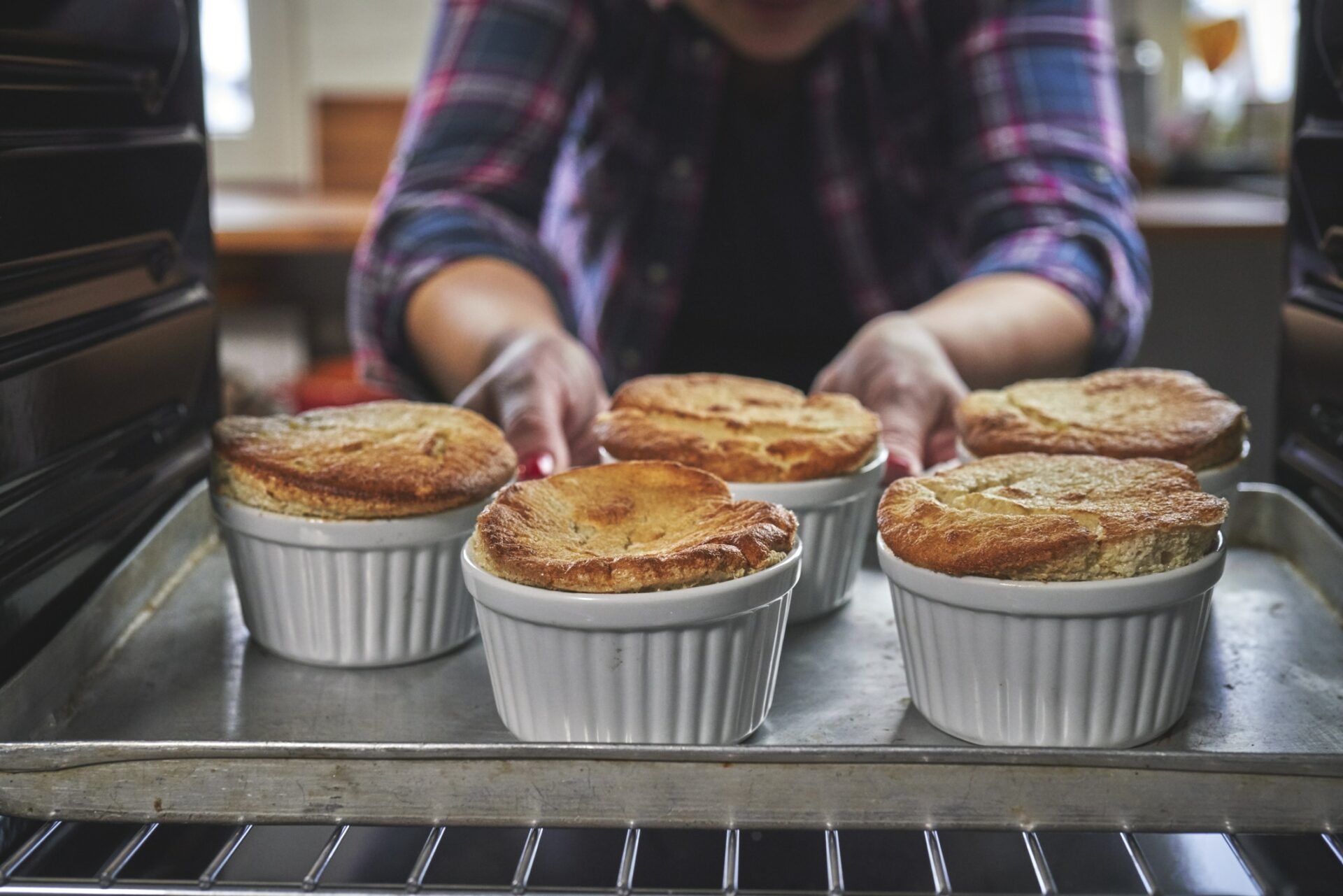
Science is everywhere in cooking, but nowhere more so than in the majestic souffle.
The word ‘souffle’ comes from the French verb souffler, which means ‘to blow’. This is a reference to the way they rise from their containers due to air bubbles trapped in their upper layers. The perfect souffle stands tall and proud with straight sides after emerging from the oven.
Souffles may be sweet or savoury and are served at a variety of courses from entree to dessert. They are traditionally baked in individual, single-serve ramekins with straight sides to help them to rise. They may also be baked in larger souffle dishes that serve multiple people.
A souffle is made up of two main components: a base of egg yolks and sauce, and an upper layer made from egg whites.
The base is made from a sauce or mixture and varies in different recipes depending on the type of souffle. Bechamel sauce, for example, is a common savoury sauce, whereas chocolate-flavoured creme is commonly used in sweet souffles. Other ingredients used to flavour the base mixture include cheese and herbs for savoury souffles, and lemon and berries for sweet souffles.

Once you’ve chosen your recipe and collected your ingredients, you’re ready to start on the four seemingly simple steps needed to make a souffle. In essence, it’s all about egg yolks, egg whites, folding and timing.
The first, and most critical step in making a successful souffle is to cleanly separate the egg yolks from the whites. Essentially, you are separating the fat contained in the yolk from the protein contained in the white. The yolk has fat and some protein, but the white is all protein and no fat. It is essential that none of the yolk gets mixed in with the white because if it does those beautiful towering souffles simply won’t form.
The second step is to make the base of your souffle. If you’re making a savoury souffle, your base might be a bechamel sauce. This French sauce is made from flour, butter, milk and egg yolks.

This step is where the magic happens. As you beat the egg whites, you’re adding air to the mixture. The protein in the egg whites forms a kind of skin around the bubbles of air resulting in a stiff mixture that forms peaks when you remove the beater.
If there is any fat present, such as if some egg yolk has leaked into the egg whites, the skin can’t form around the air bubbles, the air leaks away, and no peaks will form. If your egg white mixture does not form peaks, your souffle will not rise.
You can beat the egg whites by hand or with an electric beater. If you choose to do it by hand, bear in mind that they require a lot of beating and you must ensure that you’re able and determined enough to keep going until they’re ready. When using an electric beater, beat your egg whites on medium high speed. Whichever way you choose, use a clean metal bowl and a metal whisk to beat your whites. Keep going until the egg whites have lost their sheen and form peaks when you remove the whisk/beater. You can test the firmness of the peaks by turning the bowl upside down over your head—if you dare!
If you’re nervous about your egg whites not peaking, you can add a little bit of cream of tartar to help the structural integrity. However, if you removed the yolks properly and beat until your whites lost their sheen, you should not have to add anything.
Once they’re ready, use a spatula to fold the egg whites into the egg yolk mixture. Be careful not to overmix. Fold until the two mixtures are just blended and place the mixture into a prepared baking dish. Fill to about three-quarters full.
Be guided by your recipe in this step as different recipes call for different oven temperatures. Baking time for souffles is not long, and you should keep an eye on your souffle while it bakes—but don’t open the oven door! The cool air coming in from the open door will stop your souffles from rising.
Inside the oven, chemical reactions are happening! The heat from the oven causes the air bubbles in the egg whites to expand causing the souffles to rise. The temperature also causes the protein to stiffen. This firm protein combines with the fat from the egg yolk to create a scaffold that helps the souffle to keep its shape.
Souffles are baked in ramekins that have straight sides, so it’s easy for them to rise straight up.
Souffles are best served directly from the oven. So grab your spoon and enjoy!
Not all chemical combinations will result in a perfectly risen dessert, and they should definitely not be consumed! To avoid accidental ingestion, misidentification and mishandling of chemicals, they must be accurately labelled, tracked and stored. If you need any advice or assistance with chemical and hazard materials handling, SDS or labels for large quantities of chemicals, contact Chemwatch on (03) 9573 3100.
Sources: